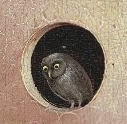








This appears to begin with the publication of Jheronimus Bosch by Jacques Combe in 1946 (there may even be an earlier French edition of 1941). In his book Combe surveys Bosch's entire oeuvre, and suggests that he used alchemical ideas and imagery, particularly in the Temptation of St Anthony and the Garden of Earthly Delights. Combe appears to have little technical knowledge of alchemical literature, or the emblematic material in manuscripts and books, and relies on some generalities. As an example consider his statement about an image on the lower right side of the central panel of the Garden of Earthly Delights.
"A conical red coral, with a dual alchemistic symbol encloses sinning couples. Nearby men are assembled in an odd-looking orange-coloured edifice budding and beaded (orange is also one of the colours frequently attributed to the Philosopher's Stone in the course of its sublimation)."This is really very weak, and shows little grasp of alchemy.
In 1979 Madeleine Bergman's Ph.D. thesis Hieronymus Bosch and Alchemy: A Study on the St Anthony Triptych was published.
In 1981 Dixon, Laurinda Dixon's Ph.D. thesis Alchemical Imagery in Bosch's Garden of Delights appeared. In this she tried to show that much of the iconography in Bosch's painting was derived from the imagery in alchemy manuscripts and books. At the end of her text she has an extensive series of some 168 illustrations through which she attempts to demonstrate her thesis. While this was convincing to some people, much of this material was printed or drawn years after Bosch's death, and the few items from before or within his lifetime are not especially persuasive.
In 1984 the Credit Communal de Belgique sponsored a large exhibition in Brussels. The art historian Jacques van Lennep wrote the detailed catalogue. The opening three chapters of the catalogue are a wonderful and scholarly exploration of alchemical imagery in manuscripts and printed books. Van Lennep then digresses with a chapter primarily on the 20th century French writer Fulcanelli's ideosyncratic view of alchemy in architecture. In his fifth chapter he turns to discuss Jan van Eyck as an alchemist, and then looks at the alchemy in Bosch's paintings. He discusses at length the alchemical interpretation of the Marriage at Cana following up an article by Laurinda Dixon. This particularly involves seeing vessels as alchemical ones. He then considers the Garden of Earthly Delights and here he sees eggs, spheres, tubes, as alchemical flasks, athanors and aludels. To van Lennep the central panel is a magnificent variation on the theme of the coniunctio, the alchemical marriage of the philosophical lovers. He quotes from the Aurora consurgens but as this only existed in a few manuscripts in Bosch's time it cannot have influenced Bosch. It merely suggests a source in alchemy for Bosch's imagery. He moves on to the Rosarium Philosophorum printed in 1550 with no earlier manuscripts known. Drawing such a parallel with a work created 45 years after Bosch's painting seems worthless. Van Lennep does not stop there but even draws on imagery in Michael Maier's books from the second decade of the 17th century, created more than a hundred years after Bosch's death. It is difficult to see what point van Lennep was making.
It seems that there is little direct connection to be found between Bosch's imagery and the alchemical material that could have been available to him in his lifetime. The advocates of an alchemical Bosch make general points about eggs being like alchemical flasks, structures that enclose people being like retorts or distillation apparatus, but this is so general as to be trite. Thus the temptation arises to look for more convincing parallels with the wonderful emblematic imagery of alchemy and ignore the fact that it was created decades, and even centuries after Bosch lived.
From the 1980's onward this alchemical perspective had so attracted general writers on Bosch, that they took it for granted as a part of his inspiration. They made Bosch into an alchemist. After all alchemy was as mysterious and enigmatic as the imagery in Bosch, so there must be a connection!
A Spanish writer Jose Antonio Bertrand, searched for alchemical imagery in his book La Alquimia en el Bosco, Durero y otros pintores del Renacimiento, Barcelona, 1989. His approach is merely suggestive, as he finds almost any round object to be an athanor. He also identifies one image as an hermaphrodite, when it clearly is not, and another creature as an alchemical dragon. He extends this to Durer and other artworks of the period, but this is again unconvincing.
Laurinda Dixon returned to writing about Bosch in her book for Phaidon in 2003. Here she tried to find alchemy in some of Bosch's paintings including the Temptations of St Anthony and of course the Garden of Earthly Delights.
"The central panel of the Garden of Earthly Delights continues the alchemical thread, picturing full-scale conjunction and the ensuing multiplication of the prima materia."What on earth does this mean ! This seems rather difficult to grasp. Here we are far away from alchemy and far away from Bosch. This outer edge of alchemical interpretation has become so brittle that it just collapses into waffle.
"The light-hearted couplings in the triptych, which sometimes occur between different species altogether, demonstrate alchemists' intention to 'engender by the forces of exuberant love', 'marrying the elements indiscriminately one form with another'. Then, 'the elements being diligently cooked, rejoice and are changed into different natures'. The flower/animal/human forms that cavort throughout Bosch's central panel ingeniously illustrate this alchemical cross breeding."









